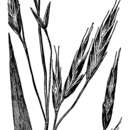Physical Description
(
Inglês
)
fornecido por USDA PLANTS text
Perennials, Terrestrial, not aquatic, Stems nodes swollen or brittle, Stems erect or ascending, Stems geniculate, decumbent, or lax, sometimes rooting at nodes, Stems caespitose, tufted, or clustered, Stems terete, round in cross section, or polygonal, Stem internodes hollow, Stems with inflorescence less than 1 m tall, Stems with inflorescence 1-2 m tall, Stems, culms, or scapes exceeding basal leaves, Leaves mostly basal, below middle of stem, Leaves mostly cauline, Leaves conspicuously 2-ranked, distichous, Leaves sheathing at base, Leaf sheath mostly closed, Leaf sheath mostly open, or loose, Leaf sheath hairy, hispid or prickly, Leaf sheath and blade differentiated, Leaf blades linear, Leaf blades 2-10 mm wide, Leaf blades 1-2 cm wide, Leaf blades mostly flat, Leaf blades more or less hairy, Ligule present, Ligule an unfringed eciliate membrane, Inflorescence terminal, Inflorescenc e an open panicle, openly paniculate, branches spreading, Inflorescence solitary, with 1 spike, fascicle, glomerule, head, or cluster per stem or culm, Inflorescence with 2-10 branches, Inflorescence branches more than 10 to numerous, Flowers bisexual, Spikelets pedicellate, Spikelets laterally compressed, Spikelet 3-10 mm wide, Spikelets with 3-7 florets, Spikelets solitary at rachis nodes, Spikelets all alike and fertille, Spikelets bisexual, Spikelets disarticulating above the glumes, glumes persistent, Spikelets disarticulating beneath or between the florets, Rachilla or pedicel glabrous, Glumes present, empty bracts, Glumes 2 clearly present, Glumes distinctly unequal, Glumes shorter than adjacent lemma, Glumes 4-7 nerved, Glumes 8-15 nerved, Lemmas thin, chartaceous, hyaline, cartilaginous, or membranous, Lemma 8-15 nerved, Lemma body or surface hairy, Lemma apex dentate, 2-fid, Lemma distinctly awned, more than 2-3 mm, Lemma with 1 awn, Lemma awn less than 1 cm long, Lemma awn subapical or dorsal, Lemma awns straight or curved to base, Lemma margins thin, lying flat, Lemma straight, Palea present, well developed, Palea membranous, hyaline, Palea shorter than lemma, Palea 2 nerved or 2 keeled, Stamens 3, Styles 2-fid, deeply 2-branched, Stigmas 2, Fruit - caryopsis, Caryopsis ellipsoid, longitudinally grooved, hilum long-linear, Caryopsis hairy at apex.
Bromus aleutensis
(
Inglês
)
fornecido por wikipedia EN

A drawing of
Bromus aleutensis found in
Manual of the Grasses of the United States.
Bromus aleutensis, commonly known as the Aleutian brome, is a perennial grass found in North America. B. aleutensis has a diploid number of 56.
Taxonomy
It has been suggested that Bromus aleutensis may be a modified version of the similar Bromus sitchensis in which reproduction occurs at an earlier developmental state as a response to the climate of the Aleutian Islands. In addition, while B. aleutensis is mostly self-fertilizing and B. sitchensis is mostly outcrossing, anther lengths close to 4.2 mm (0.17 in) in some individuals of B. aleutensis suggests outcrossing.[1]
Description
B aleutensis is a perennial grass that is loosely cespitose. The decumbent culms are 40–130 cm (16–51 in) tall and 3–7 mm (0.12–0.28 in) thick. The striate and pilose leaf sheaths have dense hairs. Auricles are rarely present. The glabrous ligules are 3.5–5 mm (0.14–0.20 in) long. The somewhat pilose leaf blades are 13–35 cm (5.1–13.8 in) long and 6–15 mm (0.24–0.59 in) wide. The open panicles are 10–28 cm (3.9–11.0 in) long. Lower branches of the inflorescence are 10 cm (3.9 in) long and number one to two per node, with two to three spikelets on their distal half. The elliptic to lanceolate spikelets are 25–40 mm (0.98–1.57 in) long, with three to six florets. The glumes are glabrous or pubescent, with the three- to five-veined lower glumes being 9–13 mm (0.35–0.51 in) and the seven- to nine-veined upper glumes being 10–15 mm (0.39–0.59 in). The lanceolate lemmas are 12–17 mm (0.47–0.67 in) and are laterally compressed and softly pubescent. The lemmas have nine to eleven veins, with the veins being especially conspicuous distally. The awns are 5–10 mm (0.20–0.39 in) and the anthers are 2.2–4.2 mm (0.087–0.165 in).[1]
Habitat and distribution
Bromus aleutensis grows in sand, gravel, and disturbed soil in the Pacific coast, particularly from the Aleutian Islands (as its specific epithet indicates) to western Washington, though it has been found farther east in lake shores or road edges of Canada and Idaho.[1][2]
Ecology
Bromus aleutensis is infected by Fusarium nivale and Hendersonia culmicola.[3]
References
-
^ a b c Mary E. Barkworth; Kathleen M. Capels; Sandy Long, eds. (2006). Flora of North America, North of Mexico: Volume 24: Magnoliophyta: Commelinidae (in Part): Poaceae, Part 1. Vol. 24 (illustrated ed.). OUP USA. p. 203. ISBN 9780195310719.
-
^ Mary E. Barkworth; Laurel K. Anderton; Kathleen M. Capels; Sandy Long; Michael B. Piep, eds. (2007). Manual of Grasses for North America. University Press of Colorado. ISBN 9780874217780.
-
^ Sprague, Roderick (1955). Check list of the diseases of grasses and cereals in Alaska. Vol. 232. Plant Disease Epidemics and Identification Section, Agricultural Research Service, United States Department of Agriculture. p. 96.

- licença
- cc-by-sa-3.0
- direitos autorais
- Wikipedia authors and editors
Bromus aleutensis: Brief Summary
(
Inglês
)
fornecido por wikipedia EN

A drawing of Bromus aleutensis found in Manual of the Grasses of the United States.
Bromus aleutensis, commonly known as the Aleutian brome, is a perennial grass found in North America. B. aleutensis has a diploid number of 56.
- licença
- cc-by-sa-3.0
- direitos autorais
- Wikipedia authors and editors


 A drawing of Bromus aleutensis found in Manual of the Grasses of the United States.
A drawing of Bromus aleutensis found in Manual of the Grasses of the United States.